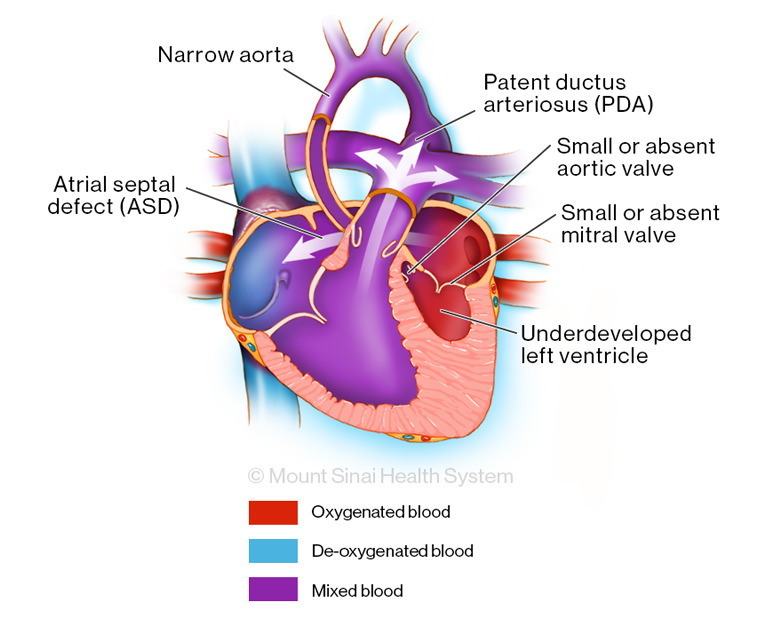
Hypoplastic Left Heart Syndrome
If your baby has hypoplastic left heart syndrome (HLHS), you can find comfort in knowing that specialists at Mount Sinai Kravis Children’s Heart Center are here to help. We have advanced diagnostics and surgical expertise along with interstage monitoring to treat and manage your child with HLHS. Our pediatric cardiologists, surgeon, other specialists, and staff are dedicated to providing excellent and compassionate care through our team approach.
About Hypoplastic Left Heart Syndrome
Hypoplastic left heart syndrome (HLHS) is a serious congenital heart defect (present at birth) that affects the left side of the heart. HLHS is one type of single ventricle defect and requires surgery to restore the heart’s function.

HLHS occurs when the left side of the heart does not form fully. As a result, the left side of the heart, which pumps blood, is unable to do its job. HLHS interrupts the normal flow of oxygenated blood to your baby’s body.
Several parts of your baby’s heart may be either too small or closed, such as:
- Left ventricle—the left lower pumping chamber
- Mitral valve—controls blood flow between the upper and lower left chambers
- Aorta—valve of the large artery that supplies oxygenated blood to the body
- Ascending aorta and aortic arch—main blood vessel supplying the body with blood
Symptoms
When your baby is born with HLHS, there may be no symptoms at first, since the blood is able to get to the body through a blood vessel that all babies are born with, the patent ductus arteriosus (PDA). Your baby’s only symptom may be a low oxygen level, which is difficult to detect by how your baby looks.
However, once the PDA closes, which it usually does within the first hours or days of life, your baby’s body will not receive enough blood.
Symptoms of HLHS that usually develop may include:
- Problems breathing
- Weak pulse
- Ashen or bluish skin color
For your baby to survive under these conditions, we must administer a medicine (prostaglandin) to keep open the PDA.
Diagnosis
Our doctors can diagnose hypoplastic left heart syndrome during pregnancy. This usually happens at the time of a regular prenatal ultrasound, when your obstetrician may notice a possible abnormality of your unborn baby’s heart. You then will need to see a specialist for a more detailed diagnosis.
Thanks to our Fetal Heart Program, if we discover HLHS during pregnancy, we can prepare you for what HLHS may mean for your baby. Our doctors and nurses will support your choice for treatment. And we offer you the opportunity to deliver your baby with us in order to make a smooth transition for care at the Children’s Heart Center. Once your baby is born, we will confirm the diagnosis and develop a treatment plan for your baby.
If HLHS is not diagnosed before your baby is born, it may be suspected based on low-oxygen levels during a congenital heart defect screening, or if your baby develops any HLHS symptoms. An accurate diagnosis can be made with an echocardiogram.
Treatments We Offer
Before we can operate, we will need to keep your baby strong and stable by using medications (such as prostaglandin to keep the PDA open). Your baby may also be able to feed a small amount before surgery, depending on his or her stability.
Then, through a series of three operations, we redirect the blood flow patterns in the heart. The first surgery is in the newborn period. The second is typically at about four to six months, and we perform the third surgery when your child is two to three years of age, though this timing can vary.
Between the first two surgeries, your baby may be especially vulnerable. During what we call the interstage period, we provide extra help, including home nursing, and frequent doctor and nurse visits to keep track of your baby’s health. Through this interstage monitoring, we are ready to step in and help prevent your baby from becoming weak or sick.
HLHS surgeries take place in a specific order:
- The first operation (Norwood procedure) creates a new large artery and connects it to the right lower chamber (ventricle), which does the pumping for your baby’s heart. At the same time, the surgeon positions a tube to get blood to the lungs for oxygen. This is a good first step, which stabilizes your baby’s circulation so your baby can leave the hospital. However, the oxygen levels are still lower than normal because oxygen-rich and oxygen-poor blood is still mixing in your baby’s heart. This surgery takes place within two weeks of your baby being born, before leaving the hospital.
- The second operation (bi-directional Glenn shunt procedure) creates a direct connection from the superior vena cava (the vein that takes blood from the head and arms) to the lungs to redirect the oxygen-poor blood from the upper part of the body. During this procedure, the surgeon removes the tube that was placed to get blood to the lungs during the Norwood operation. This second procedure lessens the strain on your baby’s right pumping chamber. We usually perform this surgery when your baby is four to six months old.
- During the third operation (Fontan procedure), our surgeon makes a connection that gets the oxygen-poor blood from the lower part of the body to your baby’s lungs. This prevents the oxygen-rich and oxygen-poor blood from mixing in the heart. Oxygen saturation levels will be near-normal as a result. After this surgery, blood from the entire body now flows directly into the lungs without going through the heart, and the heart pumps only the oxygenated blood from the lungs to the body. This third surgery is done when your baby is two to three years of age.
At the time of the Fontan procedure, it is common for the surgeon to make a small hole, or fenestration, to allow the oxygen poor blood to mix with the oxygen rich blood. This helps your child recover from the surgery. Usually we can close this hole after about a year during a cardiac catheterization, a minimally invasive procedure.
While your child may continue to need certain medications, these three surgeries allow the heart to work as best as it can to help your child to enjoy life.
Following treatment, we continue to monitor your child’s health and support you and your family in taking care of your child. We provide you with a support system of caring professionals who know you and your child personally.
Why Choose Children’s Heart Center?
At Children’s Heart Center, it’s easy to make an appointment for your child, quickly. Once here, your child will be diagnosed and treated by our dedicated specialists and staff.
Our pediatric cardiologists and surgeon work together as a team to care for your child. This team approach includes one doctor dedicated to overseeing your child’s care. Your doctor is always available to answer your questions and to explain what’s going on. This is especially important as you prepare to take your baby home during and between your child’s surgeries.
All we do is to improve your child’s quality of life. At Mount Sinai, we are here for you and your child for life.